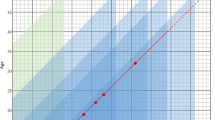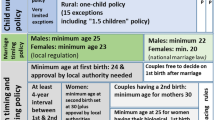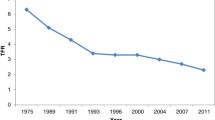Abstract
This paper considers the impact of an extended family structure on the fertility behavior of married women in Taiwan. A sequential duration model is applied to identify the differences in fertility behavior during the early and latter stages of a woman's reproductive period. Heterogeneity adjustments which correct the respondent-specific characteristics are also implemented. It is found that living with the husband's parents has an impact on the wife's fertility only at the early stage of her childbearing period, and that the subjective son preferences together with the objective fact of no son in the previous 2 births do force a wife to expedite her third birth. These results are robust across different cohorts during the demographic transition and under different specifications of hazard functions.
Similar content being viewed by others
Author information
Authors and Affiliations
Corresponding author
Additional information
We thank an anonymous referee for his or her valuable comments and suggestions.
Responsible editor: Junsen Zhang.
Rights and permissions
About this article
Cite this article
Tsay, WJ., Chu, C. The pattern of birth spacing during Taiwan's demographic transition. J Popul Econ 18, 323–336 (2005). https://doi.org/10.1007/s00148-004-0200-7
Received:
Accepted:
Issue Date:
DOI: https://doi.org/10.1007/s00148-004-0200-7




